Today, modern rock drilling and blasting technologies and geotechnical excavation operations have become the main method of obtaining resources from rock and opening up underground space for survival and development. Therefore, long-term cooperation of experts in rock drilling, blasting, rock crushing, mining, materials, metallurgy, steel and machinery is needed. The development of long-life rock drill bits has become a major engineering technology problem that must be solved in the global mining industry in the new century in order to handle rocks efficiently and at low cost.
The mining industry is one of the basic industries of the national economy. In order to improve the economy and habitat, we need to extract more resources, expand a wider living space, build easier roads, and construct more energy and defense bases. Mining rock drill bits are indispensable tools in mining and infrastructure construction. Different rock drill bit types are used in mines, railroads, highway construction, ports, power station defense projects, etc., as well as in urban construction and quarrying. In this article, you will get more about types of drill bits used in mining.
Button drill bit is suitable for dry and wet drilling of medium hard and hard rocks. It is mainly used in all kinds of mining, transportation, water conservancy, roadway, tunnel excavation, quarrying and rock breaking engineering of municipal construction.
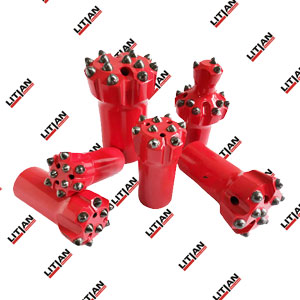
Chisel rock drill bit is suitable for light rock drills, drilling rock holes with a diameter of less than 50mm, and is suitable for rocks with low hardness. This bit is widely used in various mines such as coal mine, iron ore, gold mine, copper mine and lead-zinc mine, as well as tunnel excavation in railway, highway and water conservancy construction. Chisel Bit has mature technology, adopts high-quality steel and alloy, has high toughness and high wear resistance, high production efficiency and low cost.
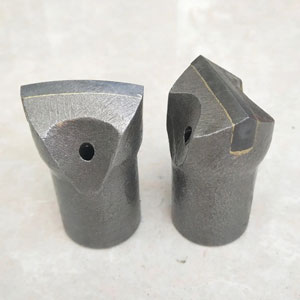
Cross rock drill bit is suitable for high-power rock drill, which can drill into complex rock strata such as rock cracks. It has strong radial wear resistance. The cross bit also adopts mature technology, high-quality steel and alloy, has strong radial wear resistance, maintains high production efficiency and can control the cost.
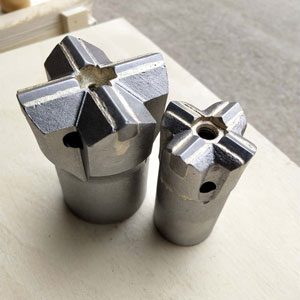
Three-edge rock drill bit is suitable for high-power rock drill. It has strong drilling ability and is suitable for high hardness and complex rocks. It is widely used in highway, railway, water conservancy construction tunnels, coal mine, iron mine, gold mine and other mining excavation.
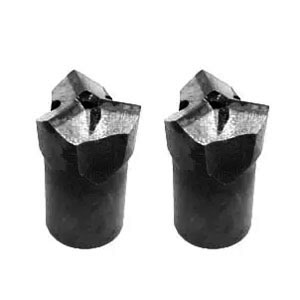
Horseshoe rock drill bit is suitable for all kinds of steel plants, blast furnace and ladle. Its main characteristics are fast opening speed and easy to control the depth and angle of channel and iron hole. The maintenance of iron hole mud bag is simple and saves manpower.
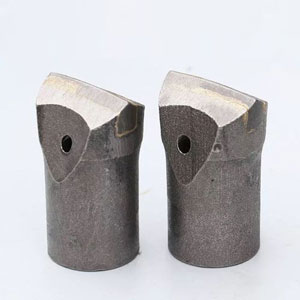
When selecting the rock drill bit, it shall be selected according to the type, performance, rock hardness and toughness of the drill bit. Generally, the chisel rock drill bit shall be selected when there is no crack in the rock; Cross rock drill bit and three-edge bit can be widely used in various rocks, especially in hard and extremely hard rocks with high abrasive cracks; The button drill bit is suitable for all kinds of rocks except high abrasive rocks.
(1). When drilling, due to the cutter feeding too fast, grinding or drilling cold and hot may cause the phenomenon of bit fracture or sudden stop;
(2). When drilling, the air volume of the rock drill shall be reduced to reduce the damage to the drill bit caused by high stress of cemented carbide parts.
As one of the mature rock drilling tools manufacturers, Litian offers a wide range of threaded button bits for sale. Contact us now if you are looking for high-quality rock drill bits!
Different top hammer rock drill bit sizes are used for various drilling applications, depending on the type of rock formation being drilled and the drilling method used. Here are some examples of how different top hammer rock drill bit sizes can be used in different applications.
Small diameter top hammer button bits (less than 2 inches): These are commonly used for drilling shallow blast holes, anchor holes, and exploration drilling in soft to medium-hard rock formations.
Medium-diameter top hammer button bits (2 to 4 inches): These are used for drilling medium blast holes in medium-hard to hard rock formations. They are also used for tunneling and drifting applications.
Large-diameter top hammer button bits (greater than 4 inches): These are used for drilling large blast holes in hard rock formations. They are also used in construction and mining applications, such as drilling shafts and tunnels.
Selecting the right top hammer rock drill bit size for the specific application is critical to ensure efficient drilling and maximum productivity. The rock drill bit sizes should be selected based on the hardness, density, depth of rock formation, and the drilling method being used. Additionally, other factors such as the type of rock drills and the power of the drilling machine may also influence the choice of button bit size.
In mining, top hammer drill tools are used to mine ore or explore for mineral deposits. Open pit and underground mining drill bits are essential tools in the mining industry. They play a crucial role in ensuring the safety and efficiency of open pit and underground mining operations. The types of drilling in mining come in various shapes and sizes, each designed for a specific type of rock or mining condition. For instance, some drill bits are designed with a conical shape for drilling in soft rock, while others have a flat or button shape for hard rock drilling. With the continuous advancement of technology, we can expect to see even more innovative and efficient drill bits being developed for the mining industry.
Rock drilling bits are also used in the quarrying industry to extract stone and other materials from the earth. They are used to drill holes into the rock, which are then filled with explosives to break apart the rock and extract the desired materials.
In tunneling and underground engineering, top hammer drilling tools are used to drill holes in rock for blasting or construction of underground structures.
Top hammer drilling tools are widely used in construction and foundation engineering for drilling rocks at construction sites or bridges and other projects to place blasting agents or perform foundation work.
General, top hammer rock drilling tools are rarely used in the oil and gas industry. However, in certain specific geological conditions or situations requiring rock reinforcement, the use of top hammer rock drilling tools may be considered. For instance, in special areas where blasting or strengthening of rock formations is needed, top hammer rock drilling tools might be used.
Overall, top hammer drilling tools have applications wherever rock drilling and preparation are required. They provide efficient, precise, and safe rock-handling solutions that enable a variety of projects to proceed smoothly.
Maintaining rock drill bits is crucial to ensure their longevity and performance. Here are some tips on how to maintain rock drill bits:
Clean the Bit Regularly: After each use, clean the bit thoroughly with a wire brush to remove any debris, dirt or rock particles that may be stuck in it. Failure to clean the bit regularly may lead to a buildup of debris that can cause damage to the bit and affect its drilling performance.
Inspect the Bit: Inspect the bit regularly to check for any signs of damage such as cracks, worn-out buttons or cones, or excessive wear. If any of these signs are present, it may be time to replace the bit.
Keep the Bit Lubricated: Lubrication is essential for the proper functioning of the bit. Make sure to use the recommended lubricants and ensure that they are applied correctly.
Store the Bit Properly: When not in use, store the bit in a dry and cool place, away from direct sunlight and moisture. This helps to prevent rust and corrosion that can affect the bit's performance.
Sharpen the Bit: A dull bit can reduce drilling efficiency and increase wear and tear. Regularly sharpen the bit using a sharpening stone or file to maintain its sharpness.
Use the Bit Correctly: Proper use of the bit is also important for its longevity. Use the correct drilling technique and avoid applying too much pressure, which can cause the bit to break.
By following these tips, you can maintain your rock drill bit and ensure that it performs at its best.